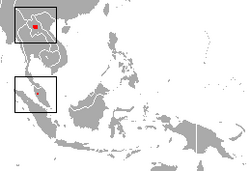Biology:Convex horseshoe bat
| Convex horseshoe bat | |
|---|---|
| Scientific classification | |
| Domain: | Eukaryota |
| Kingdom: | Animalia |
| Phylum: | Chordata |
| Class: | Mammalia |
| Order: | Chiroptera |
| Family: | Rhinolophidae |
| Genus: | Rhinolophus |
| Species: | R. convexus
|
| Binomial name | |
| Rhinolophus convexus Csorba, 1997
| |

| |
| Convex Horseshoe Bat range | |
The convex horseshoe bat (Rhinolophus convexus) is a species of bat in the family Rhinolophidae. It is found in Malaysia and Laos.[1]
Discovery and etymology
This species was first encountered by Hungarian zoologists Gábor Csorba and Ferenc Zilahy in March 1995 in the Cameron Highlands District of Malaysia. It was described by Csorba in 1997. It was given the species name convexus in reference to the "convex outline of the posterior noseleaf." The holotype is an adult female.[2]
Taxonomy
As the Rhinolophus genus is quite speciose, it is divided into closely related species groups. The convex horseshoe bat is placed into the pusillus species group.[2]
Other species belonging to this species group include:
- Acuminate horseshoe bat, R. acuminatus[3]
- Little Japanese horseshoe bat, R. cornutus[4]
- Imaizumi's horseshoe bat, R. imaizumii[5]
- Blyth's horseshoe bat, R. lepidus[6]
- Formosan lesser horseshoe bat, R. monoceros[5]
- Osgood's horseshoe bat, R. osgoodi[5]
- Least horseshoe bat, R. pusillus[5]
- Shortridge's horseshoe bat, R. shortridgei[6]
- Little Nepalese horseshoe bat, R. subbadius[6]
Description
The base of the noseleaf is narrow when viewed from the side. The lancet is short, wide, and rounded with convex margins. Its shape is similar to an equilateral triangle. The sella tapers and curves downward at the tip. The forearms are approximately 42 mm (1.7 in) long. Ears are small and blunted at the tip. The noseleaf, while broad, does not cover the sides of the muzzle. There are three grooves in its lower lip. On its back, the fur is a rich, russet brown color, and individual hairs are 6 mm (0.24 in) long. Hairs are a consistent color from base to tip. On its ventral side, the hairs are lighter in color, and individual hairs are somewhat shorter at 4.5 mm (0.18 in) long. Flight membranes are dark in color. The last vertebra of the tail extends slightly past the uropatagium.[2]
Range and habitat
One individual was collected in a montane forest of Malaysia at 1,600 m (5,200 ft).[1] The other known individual was collected in front of a cave in Laos,[7] but its taxonomic validity may be questionable.[1]
Conservation
Only two individuals of this species have ever been observed.[1] There is almost no information about their biology, ecology, population number, or range. Because of this, the IUCN lists it as data deficient.[1]
References
- ↑ 1.0 1.1 1.2 1.3 1.4 1.5 Csorba, G.; Bumrungsri, S.; Francis, C.; Görföl, T.; Bates, P.J.J. (2016). "Rhinolophus convexus". IUCN Red List of Threatened Species 2016: e.T40037A22060825. doi:10.2305/IUCN.UK.2016-2.RLTS.T40037A22060825.en. https://www.iucnredlist.org/species/40037/22060825. Retrieved 16 November 2021.
- ↑ 2.0 2.1 2.2 Csorba, G. (1997). Description of a new species of Rhinolophus (Chiroptera: Rhinolophidae) from Malaysia. Journal of Mammalogy, 78(2), 342-347.
- ↑ Bates, P. J., Thi, M. M., Nwe, T., Bu, S. S. H., Mie, K. M., Nyo, N., ... & Mackie, I. (2004). A review of Rhinolophus (Chiroptera: Rhinolophidae) from Myanmar, including three species new to the country. Acta Chiropterologica, 6(1), 23-48.
- ↑ Wu, Y., Motokawa, M., Harada, M., Thong, V. D., Lin, L. K., & Li, Y. C. (2012). Morphometric variation in the pusillus group of the genus Rhinolophus (Mammalia: Chiroptera: Rhinolophidae) in east Asia. Zoological science, 29(6), 396-402.
- ↑ 5.0 5.1 5.2 5.3 Simmons, N.B. 2005. Order Chiroptera. Pp. 312–529 in Wilson, D.E. and Reeder, D.M. (eds.). Mammal Species of the World: a taxonomic and geographic reference. 3rd ed. Baltimore: The Johns Hopkins University Press, 2 vols., 2142 pp. ISBN:978-0-8018-8221-0. Simmons, N.B. 2005. Order Chiroptera. Pp. 312–529 in Wilson, D.E. and Reeder, D.M. (eds.). Mammal Species of the World: a taxonomic and geographic reference. 3rd ed. Baltimore: The Johns Hopkins University Press, 2 vols., 2142 pp. ISBN:978-0-8018-8221-0
- ↑ 6.0 6.1 6.2 Srinivasulu, C., & Srinivasulu, B. (2012). South Asian Mammals. In South Asian Mammals (pp. 9-98). Springer New York.
- ↑ Thomas, N. M., Duckworth, J. W., Douangboubpha, B., Williams, M., & Francis, C. M. (2013). A checklist of bats (Mammalia: Chiroptera) from Lao PDR. Acta Chiropterologica, 15(1), 193-260.
Wikidata ☰ Q1765115 entry
 |


